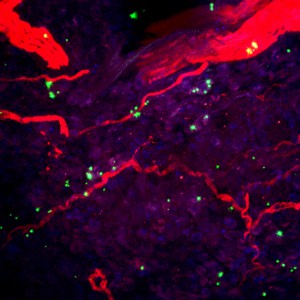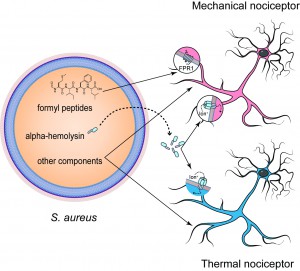
Invasive methicillin-resistant S. aureus bacteria (shown in green) cluster close to pain nerve fibers (in red) in infected skin tissue
Previously, the pain from invasive infections like meningitis, necrotizing fasciitis, urinary tract infections, dental caries and intestinal infections was thought to be due to the body’s immune response, causing the infected tissue to become inflamed and swollen.
Not so, says Boston Children’s Hospital neuro-immunologist Isaac Chiu, PhD. Studying invasive skin infections caused by methicillin-resistant Staphylococcus aureus (MRSA) in live mice, his team’s research demonstrates that the pain is induced by the bacteria themselves, and kicks in well before tissue swelling peaks.
Adding outrage to insult, once the pain-sensing neurons are activated, they suppress the immune system, potentially allowing the bacteria to proliferate, finds the study, published last week in Nature.
“If we could block pain in infected tissues and block what pain neurons do to the immune system, it could help us treat bacterial infections better,” says Chiu, who works in the laboratory of Clifford Woolf, PhD, an expert in pain biology at the F.M. Kirby Neurobiology Center.
As Chiu and colleagues describe, virulent bacteria “talk” to sensory neurons in at least two different ways. They secrete compounds called N-formyl peptides; when receptors for these compounds are blocked on pain neurons, mice show a reduced pain response. Then there are pore-forming toxins, like alpha-hemolysin shown above. These cruel molecules, one of which is already known to make S. aureus more virulent, dock on the sensory nerve terminals and create large pores that let ions into the cells—triggering them to fire off pain messages.At the very beginning, Chiu and co-author Christian Von Hehn, MD, PhD, were simply culturing sensory neurons and immune cells together in a dish to see how they interact during an infection. “Surprisingly, the neurons were responding immediately to the bacteria,” says Chiu. “This was unexpected.”
They then moved on to a live model of skin infection—the first to their knowledge ever used to study pain—working closely with Balthasar Heesters, a graduate student in the lab of Michael Carroll, PhD, in the Program in Cellular and Molecular Medicine at Boston Children’s.
Tracking bacterial infections, they were surprised to find that the activated pain neurons turn around and suppress the immune system. “I was thinking they would do the opposite,” says Chiu. “It made us start to think, what is the underlying role of pain?”
Indeed, why would our pain sensors try to weaken our immune response to infection? Chiu delved into the literature and found lots of evidence for neural regulation of immunity. During septic shock, for example, the autonomic nervous system acts to shut down inflammation. The evidence for immune suppression by neurons goes all the way down to worms.
“There could be an ancient circuit to block inflammation and protect the organism from excess damage,” Chiu speculates. “That could possibly be something the pathogens are taking advantage of.”
If so, they’re doing it in more ways than one. Experiments in mice showed that the activated sensory neurons reduce the influx of neutrophils and monocytes—important first responders to infection—and silence these immune cells via peptide molecules. When sensory neurons were eliminated through genetic techniques, the neutrophils and monocytes rebounded.
But there’s more. Ever had a bad infection that made your glands swollen and tender? That’s evidence that your pain neurons are engaged. In an ordinary infection, T-cells and B-cells migrate to the lymph nodes to generate the next wave of the immune responses. But with invasive infections, activated pain neurons suppress that migration, the researchers found. And again, when sensory neurons are eliminated in mice, T-cells and B-cells increase.
The lab’s findings suggest possible new approaches for blocking the pain caused by virulent bacteria (for more details, read the press release). Chiu and colleagues plan to explore the pain-bacteria-immune system relationship further, including the logical next step—looking for ways to prevent or counter immune suppression to better fight infections.
“The ability of virulent bacteria strains to cause pain may give them an advantage, allowing them to use the neurons to suppress immunity,” says Chiu. “Knowing how this works may allow us to enhance immunity to bacteria, but this needs to be proven.”
Citation:
![]() Chiu IM, Heesters BA, Ghasemlou N, Von Hehn CA, Zhao F, Tran J, Wainger B, Strominger A, Muralidharan S, Horswill AR, Wardenburg JB, Hwang SW, Carroll MC, & Woolf CJ (2013). Bacteria activate sensory neurons that modulate pain and inflammation. Nature PMID: 23965627
Chiu IM, Heesters BA, Ghasemlou N, Von Hehn CA, Zhao F, Tran J, Wainger B, Strominger A, Muralidharan S, Horswill AR, Wardenburg JB, Hwang SW, Carroll MC, & Woolf CJ (2013). Bacteria activate sensory neurons that modulate pain and inflammation. Nature PMID: 23965627








